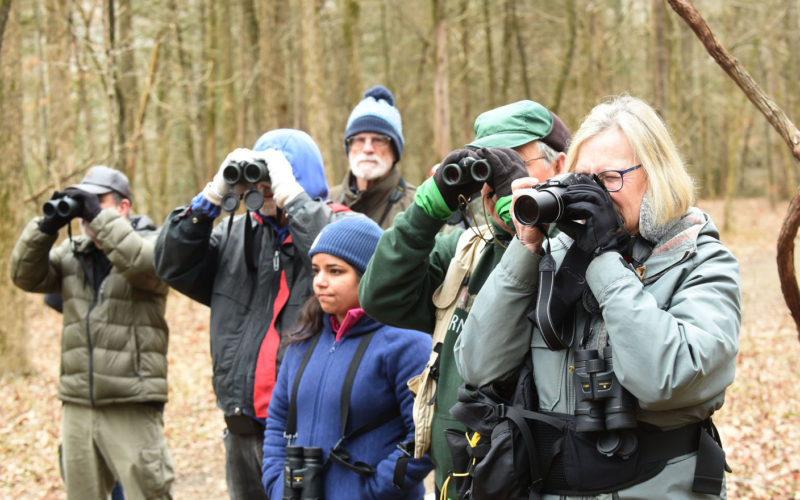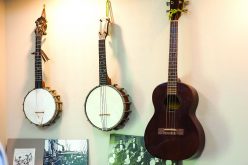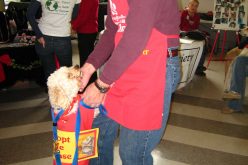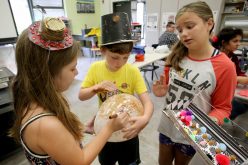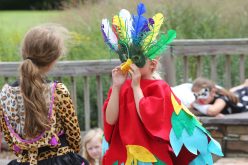Annual count inspires area birders
ELIAS WEISS
Special to The Free Weekly

The Free Weekly/FLIP PUTTHOFF
Birders record species they saw in February during a Great Backyard Bird Count field trip at Devil’s Den State Park.
Birdwatchers in all four corners of the state came together in February for the Audubon Society’s 22nd annual Great Backyard Bird Count. The event is fun for participants and helps researchers determine bird populations and migratory patterns, Audubon Society members agree.
In recognition of the Great Backyard Bird Count, the Northwest Arkansas Audubon Society organized a hike for birdwatchers of all levels of experience at Devil’s Den State Park in Winslow. Ten eager locals braved the cold weather to spend three hours cataloging the winter birds of Arkansas with Joe Neal, the secretary and field trip coordinator for the regional Audubon Society.
“We saw a good array of the winter birds that you would expect in the Boston Mountains,” Neal said after the hike. “Hermit thrushes, yellow-bellied sapsuckers, pileated woodpeckers and Eastern bluebirds.”
Neal and his team catered to novices and experts alike.

Birds Of A Feather
Annual count inspires area birders
ELIAS WEISS
Special to The Free Weekly
The Free Weekly/FLIP PUTTHOFF
Birders record species they saw in February during a Great Backyard Bird Count field trip at Devil’s Den State Park.
(double-click to edit)
The Free Weekly/FLIP PUTTHOFF
Judy Smith (center) looks at birds during the Great Backyard Bird Count last month at Devil’s Den.
“There were a couple people there who had never been out bird watching before,” Neal said. “There’s the hardcore like me, then there are other people who hardly ever go out for something like this. For them, they get an introduction to some of the biological aspects of the outdoors in Northwest Arkansas.”
Citizen science experiments like the Great Backyard Bird Count help researchers identify trends which can be linked to global issues.
“You get a lot of data, which can be used by researchers like me,” said Pooja Panwar, the president of the Northwest Arkansas Audubon Society and a graduate student at the University of Arkansas. “You can see which birds are staying south or north of their normal ranges due to climate change.”
There is something rewarding to gain for everyone in a citizen science project, Panwar said.
“Citizens like participating in events like this because they know they are contributing to a greater cause,” Panwar said. “Everyone is working toward conservation. They all have in the back of their minds, ‘I want to contribute something to nature.’”
Some birders hoped to catalog rare birds like the snowy owl, a bird native to Alaska and Canada. That single snowy owls are spotted every few years in Northwest Arkansas is an unexplained ornithological phenomenon — but it doesn’t take a rare bird to get people’s attention.
“At one point, everyone in the group was huddled around a hermit thrush,” Neal said.

File Photo
A pileated woodpecker chips away at a pergola after visiting a suet feeder designed especially for the bird’s length.
Spotting birds is a sure way to bring people together.
“If we find a really cool bird, we help everybody to look at that bird and appreciate its beauty and understand why it’s here right now,” Panwar said.
Panwar thinks Arkansas is an ideal place for birding.
“We get northern species as well as southern species,” Panwar said. “We are the northern limit of non-breeding birds and the southern limit for breeding birds.”
In 2016, Fayetteville was ranked No. 3 on the Birds & Blooms “Top 10 Bird-Friendly Cities in the U.S.”
Bird watching is appealing because nearly everyone can do it, Neal said. Roughly one in six Americans are interested in birding, whether they go out on field trips or just set up a bird feeder at home.

File Photo
A male Downy Woodpecker (left) and a Black-capped Chickadee share a bird feeder.
“So many of my friends [who bird watch] are retirees,” Neal said. “Some are so old they can barely walk. They’ll spend time every day watching the birds from home. Others will travel internationally. There are so many ways to enjoy birding.”
For Audubon Society members like Neal and Panwar, the Bird Count was about more than just citizen science: They are helping to celebrate the legacy of Doug James, who was considered the authority on birds in Arkansas. James died in December at the age of 93.
James founded the Arkansas Audubon Society and served as a professor of biological sciences at the University of Arkansas for 63 years. Together, James and Neal published Arkansas Birds in 1986.
Neal said he loves the story of how Panwar became president.
“Doug James was supposed to be the president this year, but he died in December,” Neal said. “Pooja agreed to step in and take his position as president, in addition to her own Ph.D work. It’s like having Doug still with us.”
“We want to keep Doug’s spirit going,” Panwar said.
__
Go & Do
Birding Excursion
What: All-day birding excursion through the Shores-Lake Fern area of the Ozark National Forest including visits to the Frog Bayou Wildlife Management Area and the Arkansas River.
When: 9 a.m. March 16
Where: Picnic area on the west side of the lake, Shores Lake near Mulberry
Information: nwarkaudubon.org
__

File Photo
Bird feeders come in various shapes and sizes, depending on which birds a backyard aficionado wishes to attract.
FYI
Invite Birds
To Drop In
Just because this year’s Great American Bird Count is over doesn’t mean it’s too late to get involved in birding in your own back yard. Here are some tips to create an oasis for your feathered friends:
• Different species prefer different styles of feeders, but tube feeders are versatile and appeal to a wide range of bird species. They can also handle large (think sunflower) or small seeds (like petite mixes) equally well.
• Serve a variety of bird feed. In winter, seeds with a high fat or oil content are best for birds, so offer black oil sunflower seeds, niger, raw peanuts and suet.
• In summer, offer nectar made from 1/4 cup of sugar to 1 cup of water to hummingbirds; an orange sliced in half to draw orioles; and mealworms for bluebirds.
• Keep bird seed dry. Hot, humid summer weather creates the potential for mold.
• Move feeders occasionally. Concentrations of seed hulls and bird droppings under a feeder can lead to outbreaks of salmonellosis, a bacterial sickness that can affect birds (and people).
• Put suet in the shade. Some packaged suet comes in no-melt varieties, but even these can spoil or become soft and foul a bird’s feathers in high heat.
• Clean feeders regularly. Washing feeders roughly every two weeks will keep feeders both attractive and healthy for your guests. To clean your feeder, take it apart and use a dishwasher on a hot setting or hand wash either with soap and boiling water or with a dilute bleach solution (no more than 1 part bleach to 9 parts water). Rinse thoroughly and allow to dry before refilling.
• Be sure to also offer birds plenty of fresh water.

